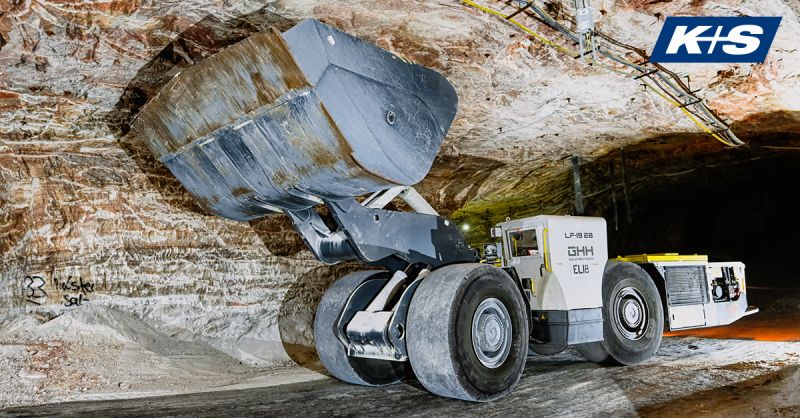Like the rest of the mining industry, Germany’s underground salt and potash mining major has ambitious climate targets. The company says it is currently working intensively on the topic of e-mobility. At its Zielitz potash mine, it says it is currently testing a BEV solution from mining equpiment major GHH based on a new generation of LHDs – with power supply delivered via a trailing cable in combination with an onboard lithium-ion battery with a capacity of 28 kWh.
The company adds that due to the enormous weight of the vehicle and the demanding operating conditions, a pure battery drive is not practicable. The GHH LF-19EB LHD with e-charger is cable powered but copers with power peaks using its battery power and can handle gradients of up to 28%. “For moving from one tipping point to the next, short distances can also be covered in pure battery operation. Recuperating is carried out as in a car when braking. For us, this is only the beginning of the K+S transport transition. In total, we will replace 133 of our large vehicles, about one third of the entire fleet, with new, low-emission models.”
The Zielitz potash mine in Saxony-Anhalt is the largest individual K+S mine and, in terms of annual output, is one of the largest and most modern potash mines in the world. Potassium-containing crude salts are extracted here for the production of fertilisers, products for industrial applications as well as products for the feed and food industries.
GHH says the LF-19EB is specifically designed for loading into a feeder breaker reducing the loss in productive time, when having to move the machine between production ends, by towing or use of a generator, by having an onboard battery so it can easily relocate using battery tramming, This provides independency compared to a traditional tethered electric loader effectively improving utilisation per shift thus improving productivity considerably. It has a 19 t payload capacity with a tractive effort force of 380 kN and an average of 250 kVA under permanent load and 315 kVA peak, with a maximum cable length of 250 m. With high payload and low height the machine is designed to operate at a maximum of 28% grade, 15% slope and a maximum of 52°C.
GHH adds: “From a running cost point of view it is significantly lower than a diesel LHD and also lower than a tethered electric LHD. The regenerative braking reduces both brake and tyre wear and there is no refuelling and a lot less maintenance due to having electrical components so costs are significantly reduced. The LF-19EB requires far less ventilation and also generates far less heat compared to a diesel LHD, resulting in a less negative impact on the operator. There is also significant energy savings compared to tethered electric and even more when compared to diesel LHDs, so this together with the lower operating costs results in an overall lower cost per tonne.”
The ergonomic operator’s compartment is designed for high comfort levels and maximum visibility. Due to a direct driven gear box, axles and an intelligent motor management, compared to hydrodynamic driven vehicles, the electric traction drive ensures an extremely smooth ride which will be welcomed by any operator. GHH says the loader “is a perfect intermediate between tethered electric and pure battery solution – more flexible than a tethered loader and less risky than a pure battery loader, based on wanting a full shift operation on one charge.”











